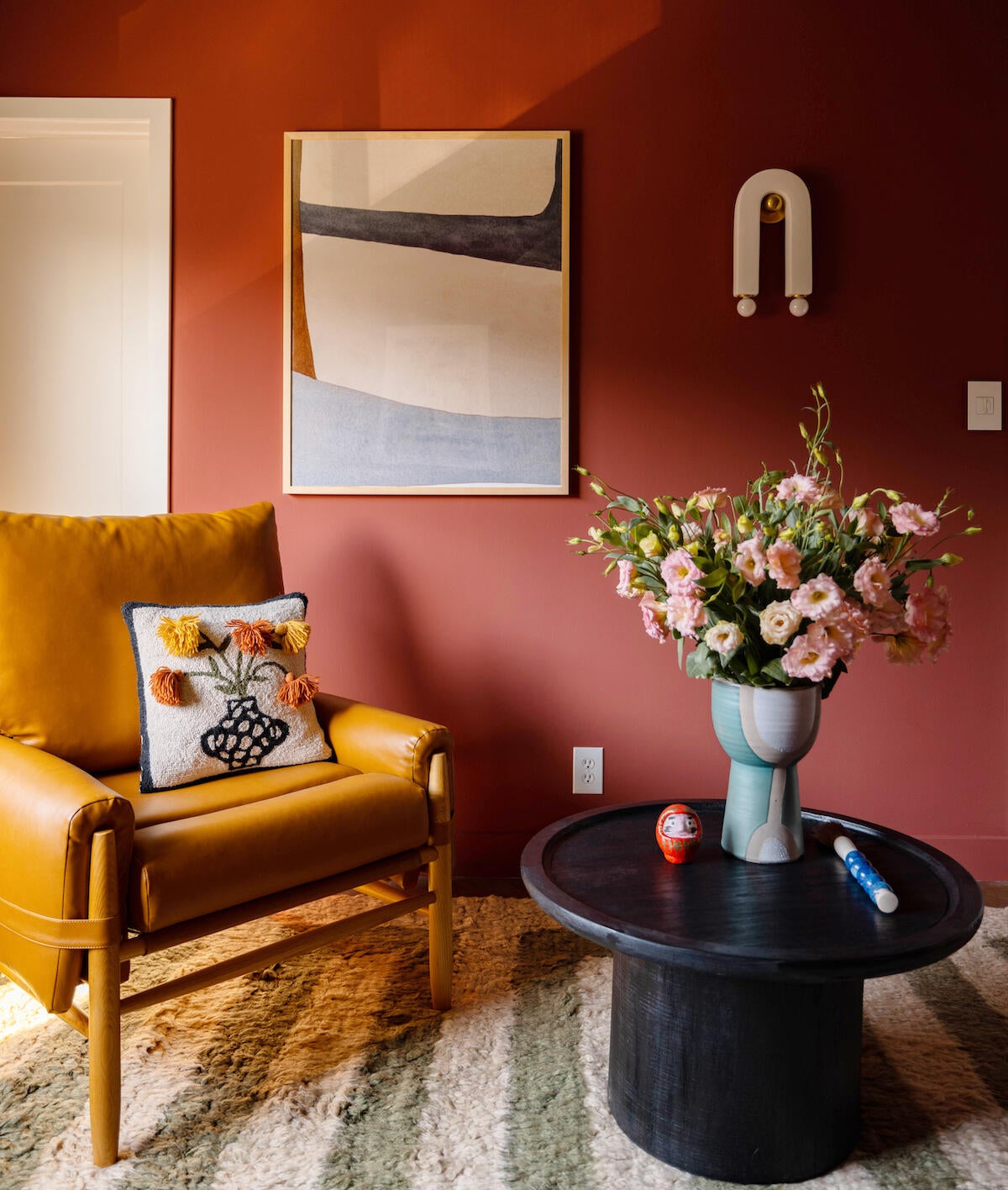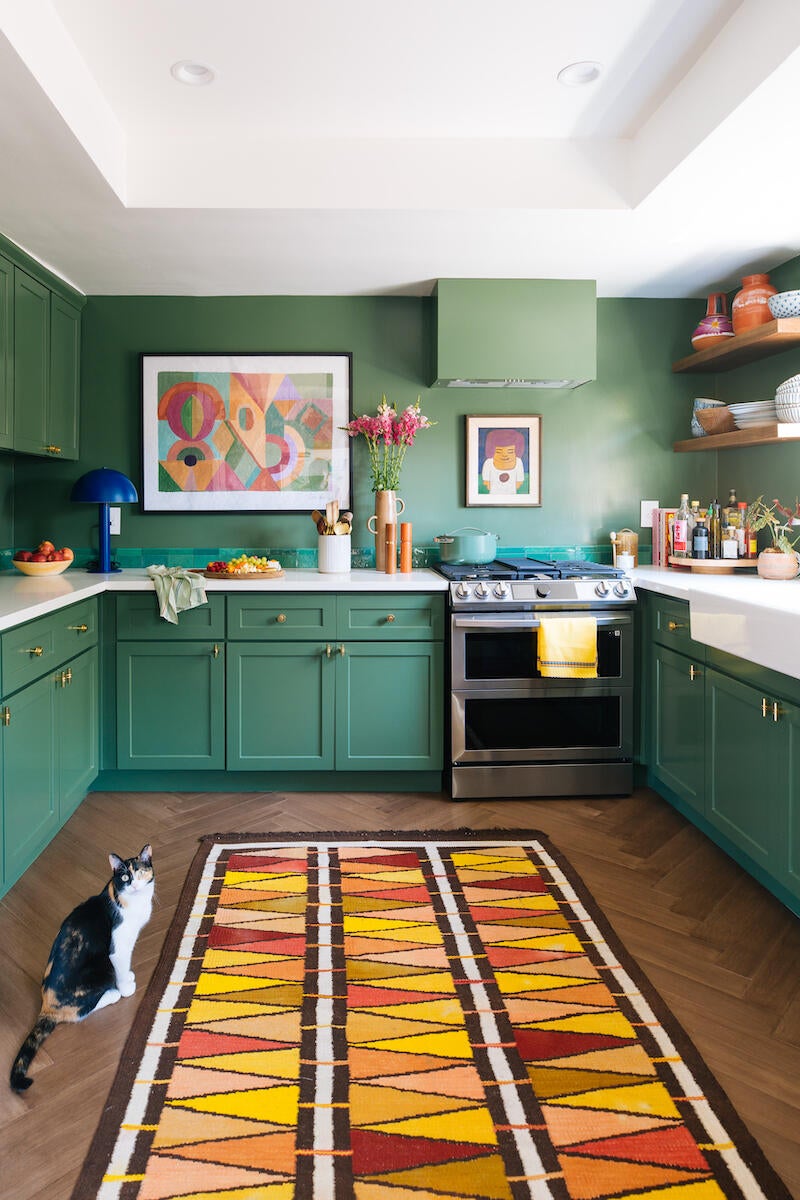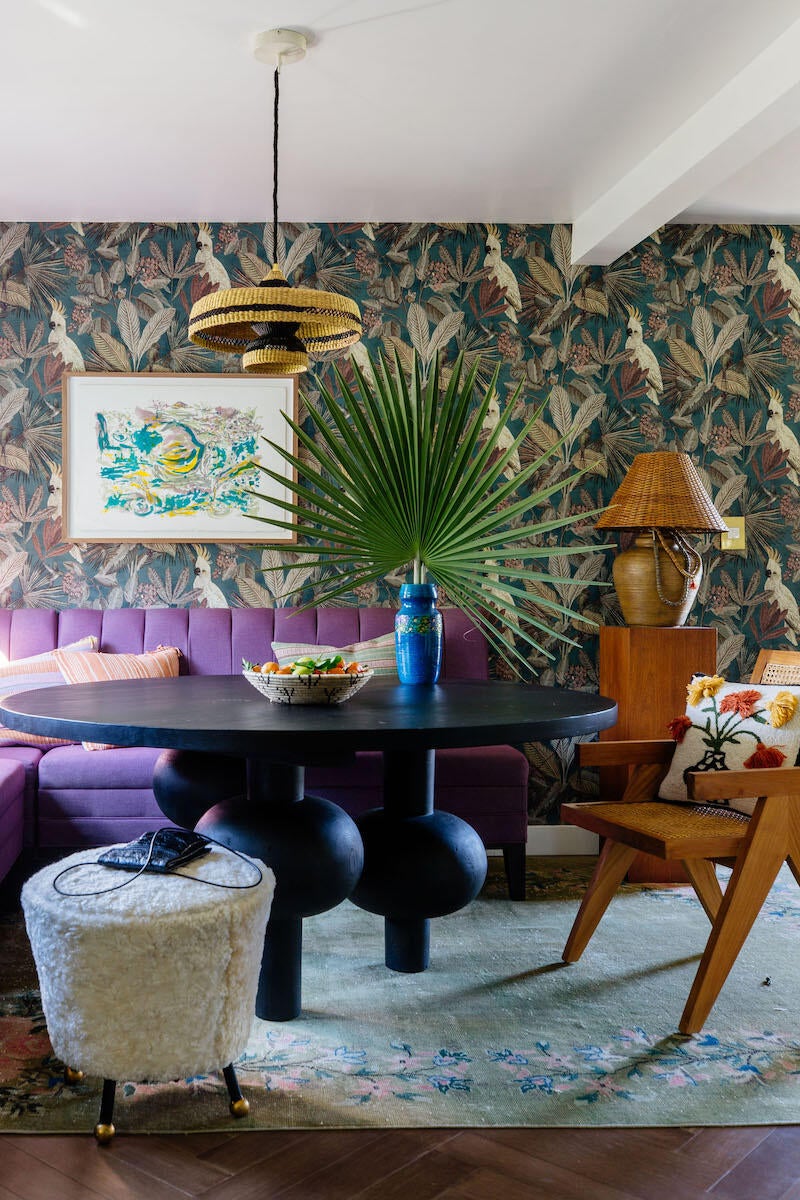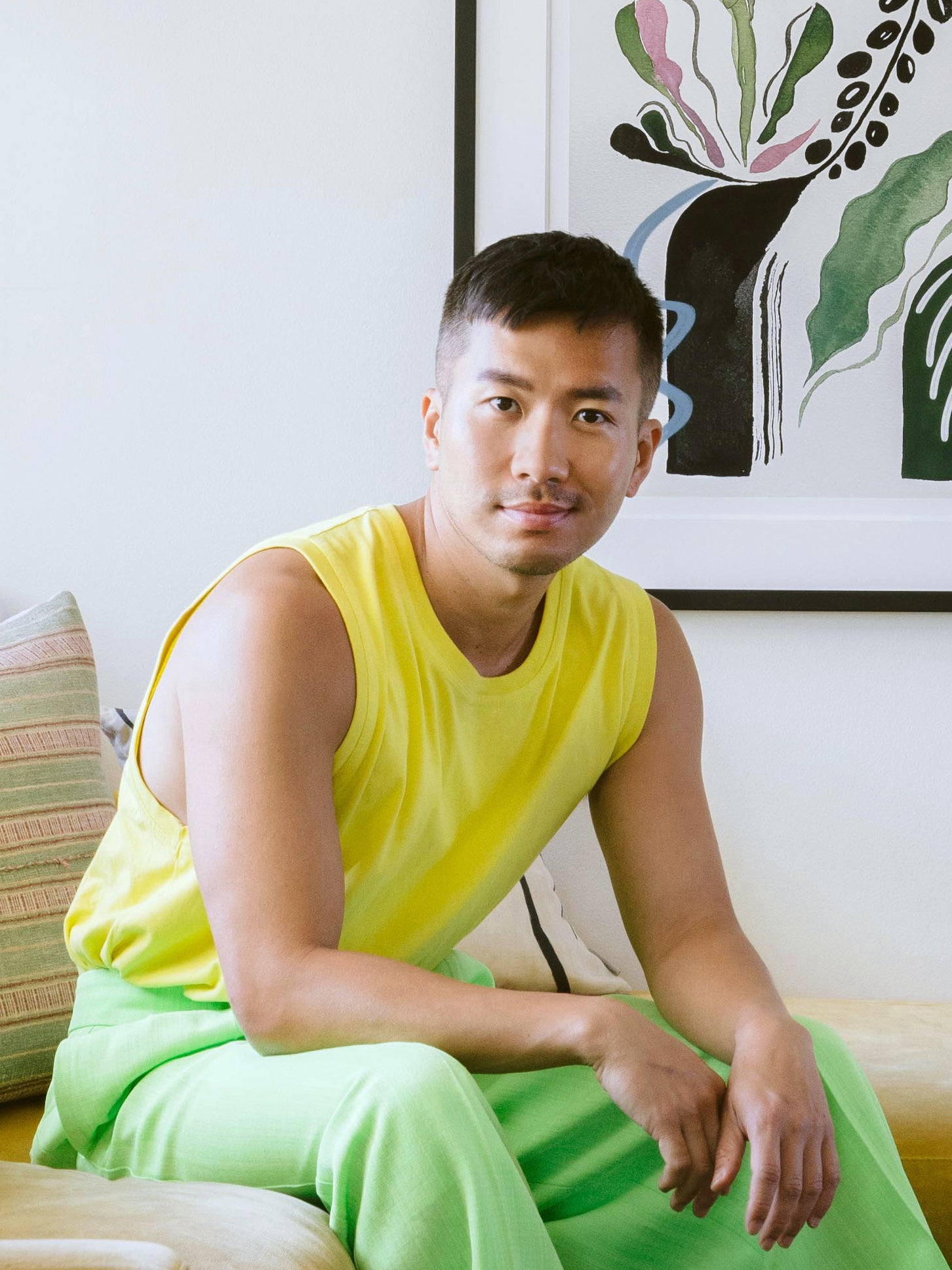In Ask an Influencer, Business of Home explores the creator economy. This week, we spoke with Dabito, the Los Angeles–based interior designer and photographer behind design blog Old Brand New.
Growing up, Dabito always dreamed of one thing: a space of his own. Instead, he shared a bedroom with his mom, dad and sister—and his aunts, uncles and grandparents lived in the rest of the house in Los Angeles. As a result, he developed a fascination with interior spaces, imagining new ways to configure room layouts, improve flow and generally liven things up. “The Ikea catalogs were pretty much my bible,” says the designer and artist, who goes by one name. “Every year, they would send the catalog and I would study and see how they style and design, not knowing that could be a career for me.”
Chasing his artistic dreams, Dabito studied printmaking and photography at the University of California, Santa Cruz, then found work as a flight attendant. He spent his regular route between the U.S. and Hong Kong dreaming about design—particularly what he saw in blogs like Design Sponge and Apartment Therapy. In 2010, when he was finally living on his own in Los Angeles, thrifting home goods and decorating on a budget, he decided it was time to enter the ring with the launch of his own design blog, called Old Brand New.
Old Brand New picked up speed during the early craze for online design blogs, and even nabbed Dabito a full-time graphic design job, which allowed him to relocate to New Orleans with his now-husband in 2014. The move, in turn, provided Dabito the opportunity to carry out his first full-scale home makeover—an experience that gave him the confidence he needed to make blogging his full-time career. Today, he broadcasts his affordable design tips and makeovers to an audience of 238,000 on Instagram, while juggling photography and printmaking projects, product licensing lines, and the forthcoming debut of his first book, Old Brand New, which hits stores this summer.
Ahead, he shares what he gains from negotiating his own contracts, how his online community is demystifying partnership rates, and why his approach to storytelling on social media involves uncovering little moments of humanity in people’s personal spaces.
How did you navigate building an audience?
I started my blog, Old Brand New, in 2010, [when] it was all about [interacting with] other bloggers. Back in the day, we would link and share other bloggers we really liked on our page, and that’s how you found [peers] who were either similar to your aesthetic or [offered] a different vibe. We would comment, email and message one another on the blogs, and that’s how we created a community—we would cross-promote one another, and other readers would discover [us that way].
Then I jumped on Instagram immediately when it launched [in 2010]. I loved it because I am a photographer, and it was another outlet for sharing photos and documenting your day-to-day journey. I would post on it regularly, just like everybody else in the blogging world. In 2014, I started seeing a lot of growth. Instagram was featuring users, and I was featured a few times—like, “Oh, here’s someone you might want to follow if you just joined Instagram.” I was able to get a lot of followers in a short amount of time. It was like a microblog, basically, to share what I was into and how I was decorating.
When did you start approaching social media with a strategy?
My strategy on Instagram was always similar to my blog: to constantly share and to always have content. I had an editorial calendar when I was blogging, and I was posting almost seven days a week. So if I blogged something, I would also share it on Instagram. On top of that, I would share three or four posts on Instagram a day, like: “Hey, there’s me at a restaurant,” or “Me in front of a building!” So it was my blog [content] plus my personal life. It’s always beneficial to post a lot—the more you share, the more visibility [you have].
I'm not precious about my work either. I don’t wait, like, “Oh, this has got to be perfect to share.” I’m like, “OK, here it is. I’m just going to share with the world, I don’t care.” That’s always been how I work: It’s always just share, create, work and share again.
When it comes to writing your blog, are you intentional about your voice and the details you share?
I keep it pretty personal. How I talk is how I write. If I’m silly, I’m silly. If I’m using f-bombs, I’m gonna use them. I think that is how [content really resonates with] people—if you’re being your true self, not a character.
It’s funny, writing has always been one of my least favorite things to do, and I feel like it has always been one of my weaknesses. Growing up, in English class—I struggled with it in high school, and then I struggled in college writing those five- and 10-page papers. For art history class, I would paint instead. I did a painting of what I studied the entire quarter, and I was like, “This is what I feel like I’ve learned,” and that was my final. So writing has always been tricky for me, but that’s the great thing about blogging: It just allowed me to be free, practice writing and let go of “oh, you should write this way.” I was like, “This is my blog. I own this. I can write however I feel, however I talk. It’s just me. Don’t overthink it.” I try not to overthink anything, especially when it comes to decorating and design and writing. Overthinking is what stifles a lot of projects and creativity. Now I’m like, writing isn’t that hard anymore, because I’ve done it so much through blogging—and now I wrote a book!

Is any part of your book drawn from the blog?
Absolutely—the book is basically an extension of my blog. I came up with the name Old Brand New for my blog because I was really into decorating, before-and-afters, vintage things, shopping—old and new: You could turn something old into something brand-new, turn brand-new spaces into feeling like they’re old again. So the book is also titled Old Brand New, and it’s filled with colorful homes for maximal living because I’m all about patterns and color and prints and [the idea that] more is more. The book features my work—all the spaces I’ve decorated over the course of my 10-year career. It features my friends’ spaces that I’ve worked on, and my family and a few clients, and a lot of before-and-afters as well.
[The book also includes] stories from my journey, how I started as a flight attendant, how I grew up with no bedrooms, and my family’s space where my mom, sister and niece were sharing a one-bedroom apartment, and how we helped level them up [into] a bigger space—now they all have their own space. It features my L.A. house and my New Orleans home. There are some new spaces and spaces I’ve shared already on my blog. I’ve categorized [the book] by the people, actually, so my home is sandwiched between my friends’, my family, a couple of clients, and I’ve also featured their portraits so people can identify [and relate to] them. It’s a book to empower people to have fun owning their spaces, even if they’re renting.
How do you decide how much of your personal life makes it on to your social media?
It’s a tricky balance. If it’s a meaningful story, I think it’s always worthy to share. For example, my mom was a refugee who came here in the late 1970s, and she tends to be a little bit of a hoarder. She saves a lot of things and keeps a lot of Tupperware containers and plastic bags and things like that, and organization is really difficult for her. I wanted to share [on my blog] that this is how it is and how I grew up, and it is still happening. It was really meaningful to see the responses. I learned a lot too—people were sharing their stories, telling me, “Oh, did you know that this typically happens because it’s a form of trauma from displacement, and people hold on to things because of the new memories they represent.” Every little thing, even if it’s an empty bag, can be meaningful to people. I didn’t realize that; I was just like, “Why did my mom keep so many things? Why can’t she just toss it out? It’s just garbage.”
That’s when I realized that decorating and design can be a very sensitive issue. When you’re holding on to so many things, it can really consume you and drag you down. I think that’s the lovely thing about social media: You can be as personal as you want, and sharing a little bit really helps people connect with you. There are these special moments where it’s not just about me, me, me, but [a more] meaningful story behind it. Sometimes I’m like, “Oh, my God, it’s just me and my face again.” In front of a wall, at a restaurant—you feel so vain, but it’s these little moments sprinkled throughout that have meaning.
I’m always questioning, “Why am I on social media?” There’s got to be a meaningful side to it, so when I transform a space for somebody, whether it’s a friend and a family or a client, it’s about finding the story.
Do you have a policy for engaging with followers?
I try to read all the comments and answer them in a timely manner, though sometimes it can be too much. With DMs, it’s a different story. Over the past few years, I don’t really check my DMs that much anymore. I don’t allow everyone to just come into my DMs—they have to request, and I keep that private. That’s my boundary. What I’ve learned from the past is that if I accept random DM requests and people have questions for me, it can become an ongoing thing [involving] access to me and my time and space, and that can overwhelm me.
How does social media factor into your business?
The big chunk of where I make my money is from brand partnerships, and I work the partnerships into design projects. It’s a lot of makeover spaces. It could include home decor brands, hardware brands, lighting brands, alcohol brands, and just really finding a different take on “how does this inspire your home, and how do we make that into a meaningful story and a makeover?”
I do have some product licensing—a collection with Mitzi lighting. Now I also have the book, and I have my own Old Brand New shop where I sell my prints. Occasionally, I’ll have affiliate links here and there. With social media, you can make a lot of money and diversify your income through a lot of channels, but I keep it pretty minimal. I’ve been really lucky, [being able to] just focus on brand partnerships, and that’s been really fun for me, [allowing me] full creative control. Typically, brands reach out to me [directly] or through an agency. I have a really good relationship with a lot of these agencies, so they always keep me in mind for other future partnerships if things align.


How do you decide what your rates are?
I do all my own negotiations. I love it. A lot of influencers have an agent do it, but I’m a one-man show: I do all my negotiations, I do all my designs, I do all my styling, I do a lot of photography, I do all my shopping—and all my returns! I am a control freak. You learn a lot about how much time it takes to create something. I love creating meaningful stories and transforming before-and-afters on these makeovers, but in the beginning, I didn’t realize how much time and money it took. It’s more than just an outfit or a quick little recipe. Creating a whole space involves the entire room—you could have to paint, you might need electrical, or a handyman, or furniture, art, florals and food—and if you need to be in a photo, you need clothes. In the beginning, it took me a while to realize the value and the business expense of creating an entire story.
Then I realized I’ve also got to pay myself—after all, I’m the lawyer, the stylist, the photographer, the creative director. Realizing that helped a lot in working out my own rates, but it took a while to get there. Basically, I’m producing an ad campaign, and I’m doing it all myself. If a brand were to do it themselves, they would have to hire someone to scout and rent a space, and it would be a huge production. I’ve learned a lot and figured out my rates and my value.
What was the path to figuring that out?
I think it’s important to find a creative community of people who are in the same field—and if you don’t have friends in the industry, just reach out to people, build a rapport and then figure out those rates together. I have had a lot of people reach out to me, and I’m very open to talking about numbers. I love talking about money—I grew up talking a lot about money, because when you’re an immigrant, everything’s so abstract and mysterious, and nobody knows how much you’re supposed to make. For the longest time, I thought making $25,000 was a goal. Then when you make that, you’re like, “Wait a minute, why am I still living paycheck to paycheck?”
When [my industry friends and I] are talking, it’s like, “I got a new job. Guess how much they’re paying me?” And I’m like, “Oh my God, that’s great!” or “Wait a minute, that’s a little bit too low for you.” We push one another. That way we can all be more transparent [about] how much money is out there for us. Sometimes people are still weirded out by it—there are always going to be people who are weird and protective about it. But I tell people. When I hosted a mentor dinner at the Meridian [Experience Weekend] conference, I was very open about how much you should charge. Otherwise, it’s definitely trial and error, and you have to figure it out just by seeing how brands respond.
As creatives, there’s such a weird dynamic around money. People are very precious—like, “Am I selling out?” I don’t think a lot of artists know how to market themselves or put a price tag on their work. Because I’ve worked with and been approached by so many different brands, I’ve been able to figure out what’s too much [to ask for] or what’s too low. Even if they have a budget, it’s a negotiation. I grew up going to Chinatown with my family, and when we went shopping, they were always negotiating. That’s what you have to do with contracts as well.
What does the physical process of producing content look like for you?
I have my digital camera, my mirrorless Canon, my tripod and also my laptop, and sometimes I’ll connect it simultaneously so I can see what the images look like and shuffle things around while styling. That way you can make adjustments—especially if the client is particular, or you need to make sure that something with a label that needs to be shown a lot is facing the camera. If I need special lighting equipment, then I’ll have flashes, but typically I work fast and pretty minimally.
Because I’m a one-man show, I’ll put things together and style it myself. When it comes to installs, I’ll typically have an assistant help me put the whole room together. I’ll have contractors for painting and handymen for work like that. I’ll source the accessories, flowers and plants to fill it all up and make all the magic happen, and then once I’m done, I edit the photos myself, write all the copy and place it all in a Google folder.
What’s your response to the shift toward video?
It’s a different producing process—it takes more time to edit videos, even with the tools that make it quicker. For a photo, you produce it and you touch it up and it’s done. With videos, you have to make sure things sync and flow. There’s definitely pressure, and this is the new wave, but there’s always going to be a new wave. I’ve been lucky that I caught the blogging wave and the early social media wave, so I’ve already built a following, but for people who are just starting now, this is what you’ve got to do. If you want to blow up now, if you want to find visibility, Reels and videos are the only way to start. I always tell people, you have to ride what’s current—and you may need at least two waves to succeed. Then again, there are a lot of people finding success and getting book offers just by doing TikTok, and that’s great.
Homepage image: Dabito | Courtesy of Old Brand New





























